An Owl Tour today. It was not the best of weather to go looking for owls – cold, cloudy and damp this morning. The weather forecast promised us it would brighten up during the day, so we thought we might get lucky.
It had been raining overnight, so we decided to have a drive round some likely areas to see if we could find a hungry Barn Owl still out trying to find some breakfast. Sure enough, just about the first bird we came across was a Barn Owl!
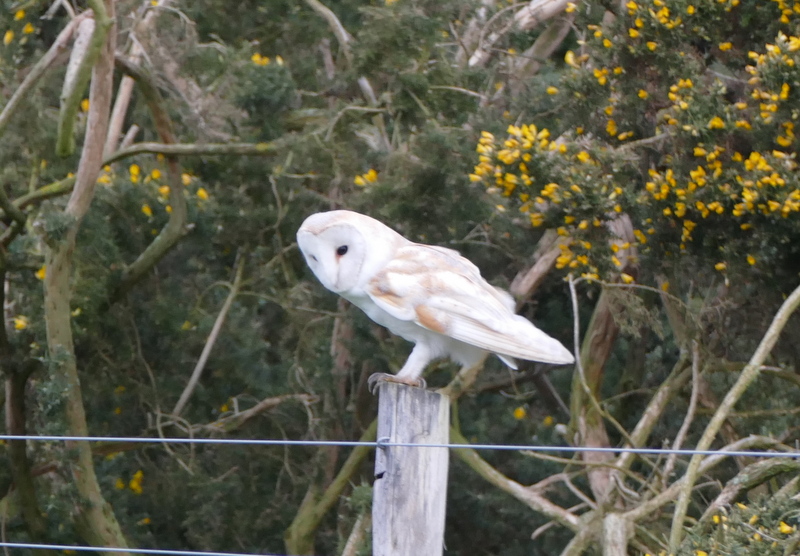 Barn Owl – just about the first bird we say this morning
Barn Owl – just about the first bird we say this morning
It was perched on a post just the other side of the hedge, so we edged the car forwards until we got to a gate so we could see it. It was watching us coming and after a few seconds, it took off and glided silently away behind the hedge. Still, it was a great way to start the day.
No more Barn Owls were out around the regular meadows this morning, so we set off to try our luck with Little Owls next. When we got to the first site, it was cold and windy and the moisture was still dripping from the barn roof. Sensibly all the Little Owls had tucked themselves down somewhere warm. Our second Barn Owl of the day was perched in a small tree on the verge, but flew off before we could stop. It flew off through the trees, but we could see it working its way along parallel to the road, so we drove back and got ahead of it in an open gateway. It flew silently straight past us and into the trees the other side.
We got out and scanned the surrounding fields, keeping our eyes peeled in case a Little Owl should pop out. A flock of Golden Plover flew over, as did a couple of Yellowhammers. Several Stock Doves were flying around the barns and we got one in the scope. A Great Spotted Woodpecker called from the trees. A couple of Brown Hares were hunkered down and remarkably hard to see in the short winter wheat.
We drove round via a couple more barns on the off chance there might still be some owls out, but they had all gone in to roost. Given the weather, we decided to move on and return to owling later in the day. We made our way across inland to Choseley.
There was no sign of the Rough-legged Buzzard at first at any of its regular spots. We had stopped below the drying barns to scan the hedges to see if we could see it from there when we picked up a large raptor way off to the east. It was too far to make out any detail, but it looked the right shape and even better it was coming our way. Then it turned and headed north, disappearing behind the trees. It seemed to be heading in the direction of one of its favourite trees, so we leapt back in the car and hurried round to check. Sure enough, there was the Rough-legged Buzzard, perched in the tree preening.
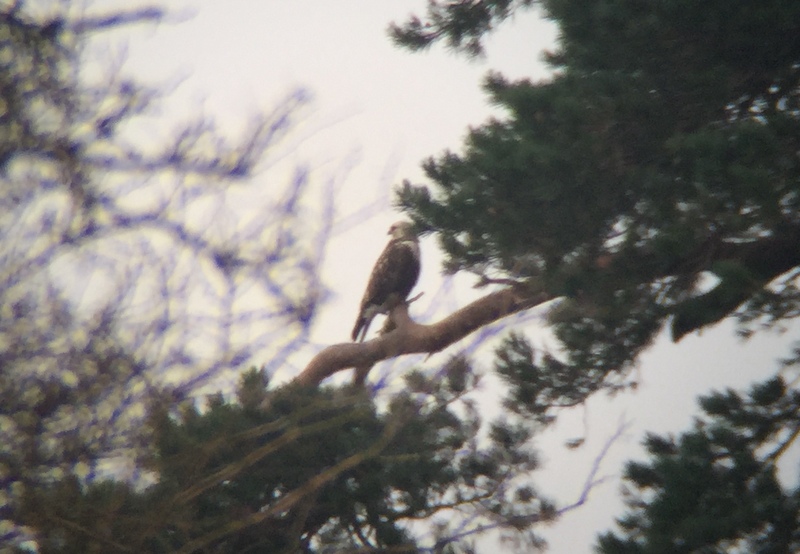 Rough-legged Buzzard – flew in from the east
Rough-legged Buzzard – flew in from the east
It was a bit distant from here, so we drove round to the other side. We were much closer, but it was slightly obscured by a branch. As we walked round to get a better angle, a Common Buzzard flew past and the Rough-legged Buzzard flew off with it. The two hung in the air together, before dropping down in the direction we had just come. Back in the car and back round and there was the Rough-legged Buzzard in another of its favourite trees, though this time well hidden in the branches. It seemed like it just wasn’t going to come out and show us its best side today.
Then it dropped out of the tree and flew along the hedge, giving us a great view of its mostly white tail and black belly patch. It headed off away from us over the trees, but at that point one of the local Carrion Crows decided to take an interest and started mobbing it. The Rough-legged Buzzard turned back towards us, with the Crow in pursuit and came straight towards us, giving us some great flight views. It’s not often you have a Carrion Crow to thank!
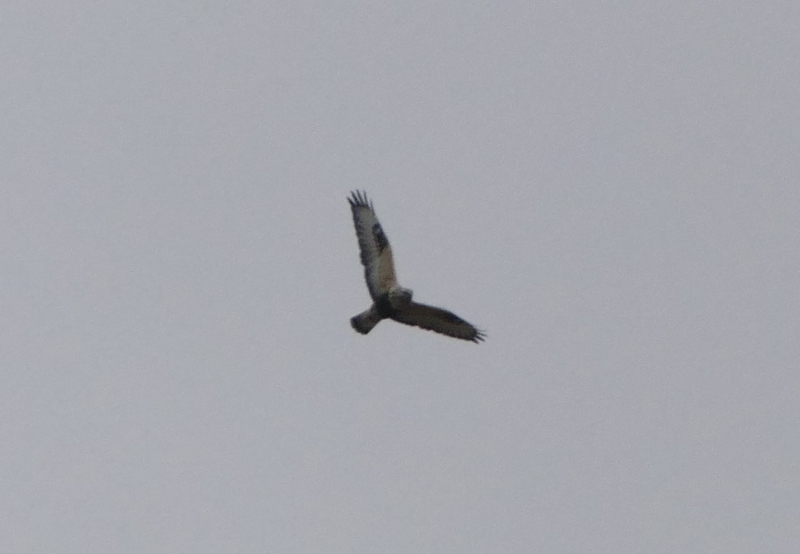 Rough-legged Buzzard – came almost overhead, pursued by a Crow
Rough-legged Buzzard – came almost overhead, pursued by a Crow
With that one in the bag, we dropped down to Titchwell to have a quick look round the reserve. The feeders in front of the Visitor Centre were packed with a variety of the commoner finches – Greenfinches, Goldfinches and Chaffinches – but in amongst the birds round the other side, we picked up a female Brambling straight away. Even better a brighter male appeared as well shortly after and the two of them kept dropping down to feed. The male Brambling had a noticeably black face, but much of the rest of its head and mantle was still speckled with pale buff-brown, as the pale feather fringes only wear off gradually to produce the black head and back in summer plumage.
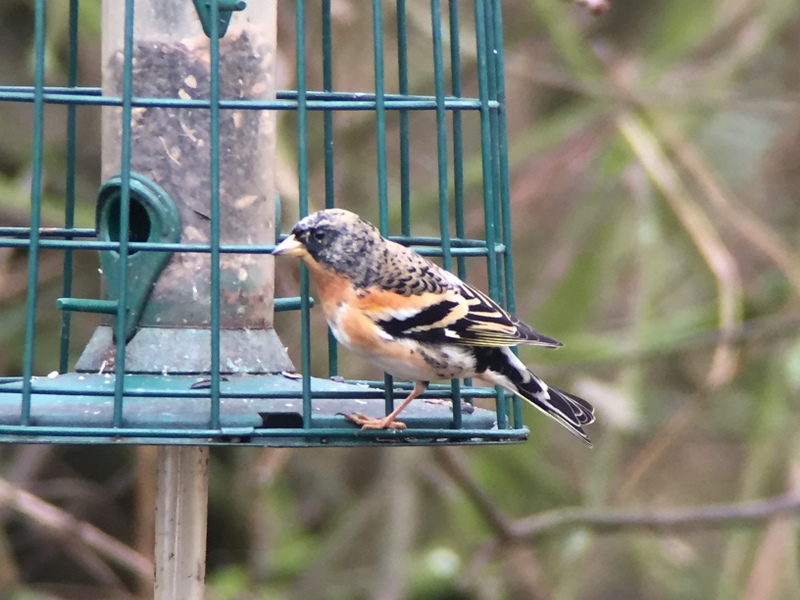 Brambling – a male in winter plumage
Brambling – a male in winter plumage
Out on the main path, we stopped to scan the ditch and didn’t have to look very hard today – the Water Rail was right out in the open in front of us, digging around in the rotting leaves in the bottom. We got a great extended look at it today, and it really posed for the photographers.
 Water Rail – in the bottom of the ditch as usual
Water Rail – in the bottom of the ditch as usual
The grazing meadow ‘pool’ is still fairly dry, although with a few more puddles after the recent rain. It is very much to the pipits liking at the moment, and there were lots of Rock Pipits on there today, at least 15. It took some careful scanning to find the single Water Pipit in with them – it was down in the ditch to one side at first, before it flew out and landed by one of the puddles. It was remarkably well camouflaged against the grey-brown mud, but when it turned it much whiter and less heavily streaked underparts than the Rock Pipits became obvious.
We headed for the shelter of Island Hide to scan the freshmarsh. There were quite a few people in there already and we could see them looking intently at the mud just below. Another Water Rail was working its way along through the cut reeds right in front – another stunning view of this often very secretive species. When something spooked it, it ran with its neck stretched out in front towards the reeds.
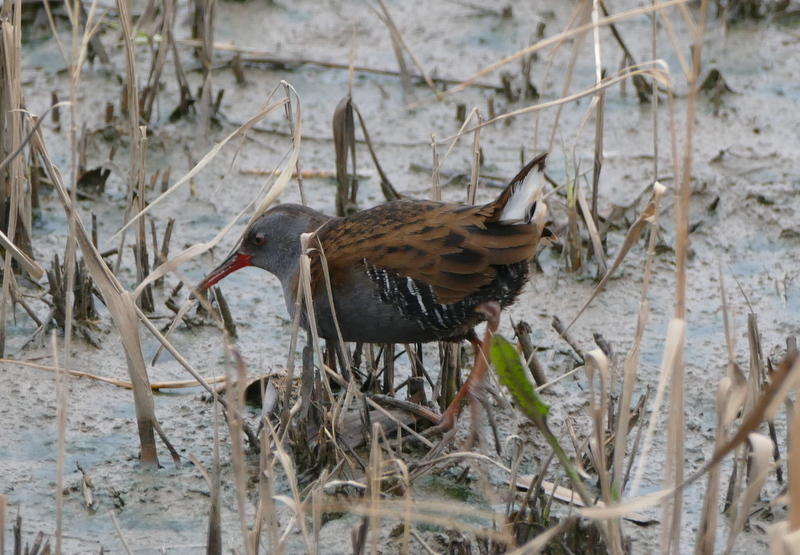 Water Rail – this one was right in front of Island Hide
Water Rail – this one was right in front of Island Hide
The water level on the freshmarsh continues to drop and there is a lot more exposed mud at the moment. There were lots more waders on here today, but mostly Lapwing and a large flock of Golden Plover. The latter were spooked continually and wheeled round en masse before dropping back to the mud. The Avocets were mostly asleep in the shallow water by one of the islands, with still around 35 present, a very good number for the time of year. There were also quite a few Black-tailed Godwits, a scattering of Dunlin around the edges of the islands and a couple of Redshank.
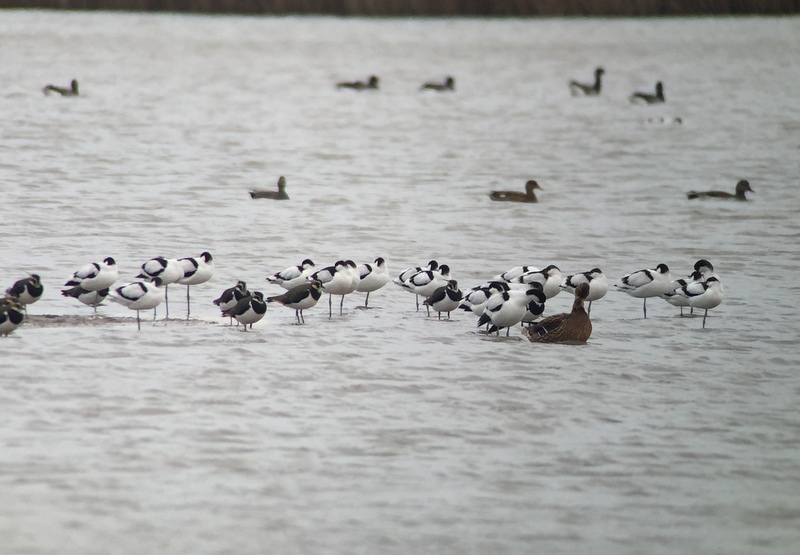 Avocets – still around 35 on the freshmarsh
Avocets – still around 35 on the freshmarsh
A flock of Brent Geese had come in to bathe when we arrived, but gradually drifted off back towards the saltmarsh. There were also plenty of ducks – particularly Teal, with some smart drakes and accompanying females feeding on the mud right below the hide. A sizeable party of Shoveler were swimming around in the deeper water further out, barely lifting their heads up out of the water as they fed. There were also a few Gadwall amongst the Mallards and a small number of Wigeon. Most of the latter are usually to be found feeding out on the saltmarsh. Further over, we got the scope on a stunning drake Pintail – there were actually several on here again today.
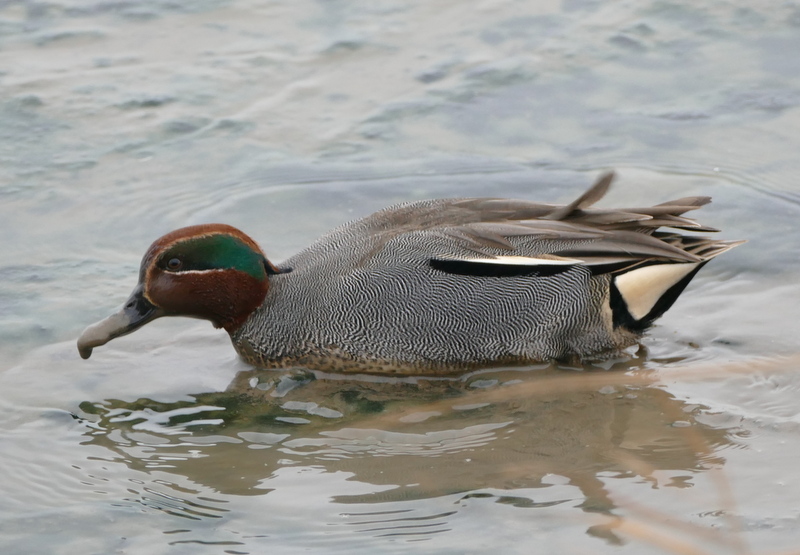 Teal – a very smart drake
Teal – a very smart drake
As we came out of Island Hide and climbed back up towards the main path, we could see a few people further along looking intently out over the saltmarsh. Once we got up there, we could see why – a cracking grey male Hen Harrier was hunting up and down out towards the dunes. As it did so, it flushed a Merlin from the bushes, which flew after it for a short while, fast and low, before flicking up and away over the dunes. The Hen Harrier was a little distant, but we got it in the scope and had a good look at it, before it drifted off towards Thornham Harbour.
We carried on out towards the Volunteer Marsh, stopping to scan for waders. A smart, white-spangled Grey Plover was walking about on the mud. A little group of Knot were working their way round the edge of the vegetation. Closer to us, a Ringed Plover was preening on the edge of one of the muddy channels.
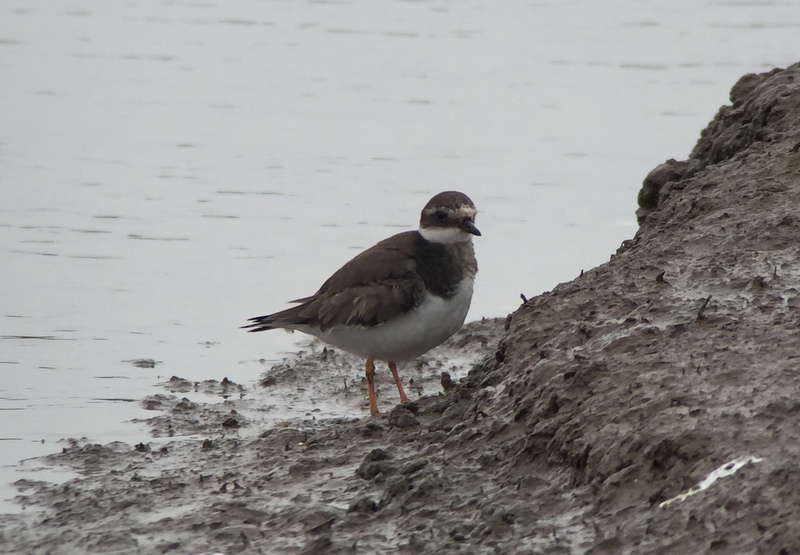 Ringed Plover – on the Volunteer Marsh
Ringed Plover – on the Volunteer Marsh
As we walked along a little further, we could see the male Hen Harrier again, closer to us over the saltmarsh. It wheeled round a couple of times, scattering pipits from the ground below it, before turning and flying straight towards us, crossing the main path right in front of us before working its way east along the bank between the Volunteer Marsh and the Tidal Pools. What a stunning bird – ghostly grey, with black wing tips, when it came past us we could see its grey hood and white rump.
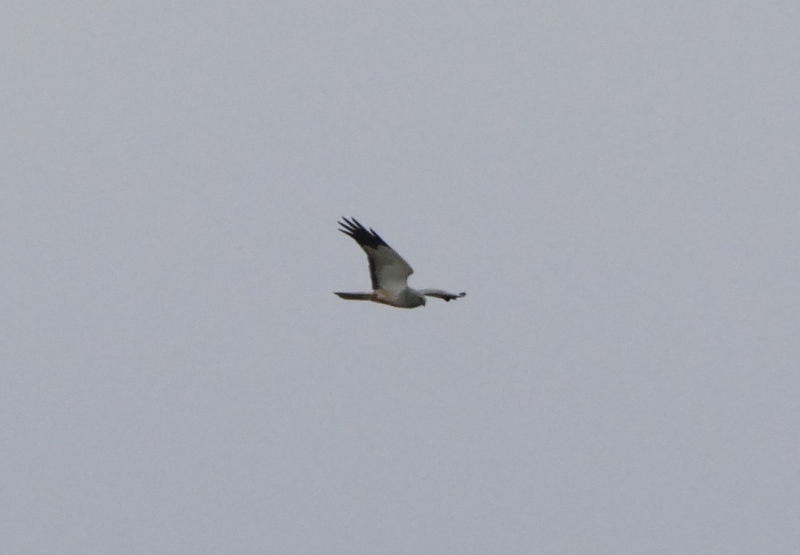 Hen Harrier – this stunning male flew across in front of us
Hen Harrier – this stunning male flew across in front of us
We thought the Hen Harrier might have scattered all the birds from the Tidal Pools, as everything took flight from the edge of the Volunteer Marsh as it flew over. Thankfully, when we got out to the Tidal Pools, we could see the most important birds still in place. Three Spotted Redshanks were wading in the deeper water at the back, with a Common Redshank just behind them on the edge of the mud. The Spotted Redshanks were obviously paler, silvery grey above and white below, with a longer, finer bill. Along the edge of the water to one side, a Greenshank completed the set of our ‘shanks’, all around one tiny area of water.
There were several Little Grebes diving in the water near the bank, as well as a female Goldeneye at the back. Further along, towards the beach, another pair of Goldeneye were ‘snorkelling’ in the shallows – swimming along with their heads under water. We also stopped to admire another smart drake Pintail, upending in the deeper water.
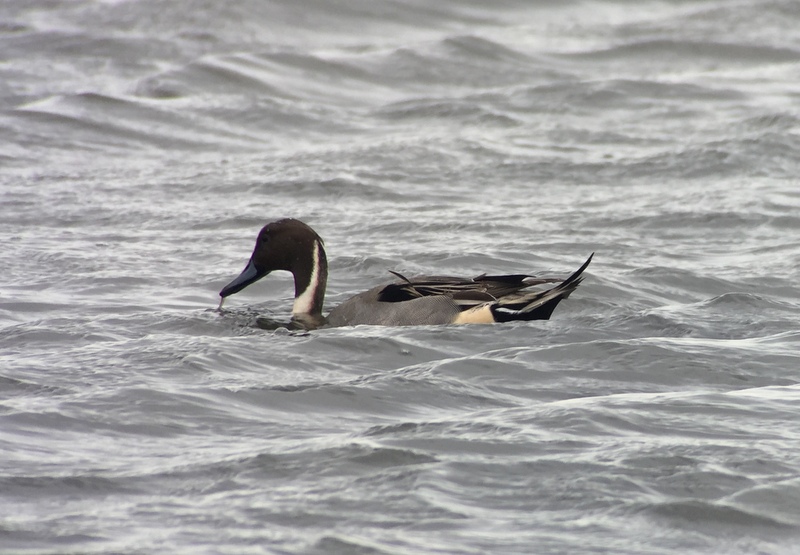 Pintail – out on the Tidal Pools
Pintail – out on the Tidal Pools
We paid a quick visit to the beach. The tide was quite a way out, so there were more waders on the shore today, but several bait diggers meant they had mostly moved along further to left and right. There were good numbers of Bar-tailed Godwits down on the beach and we added Turnstone and Oystercatcher to the day’s list.
Scanning the sea, a couple of drake Red-breasted Mergansers were close inshore, so we had a good look at one of those in the scope. There were also a few Goldeneye as usual. A line of Common Scoters were bobbing about in the waves much further out, so we focused our attention initially on two females closer in. It was only a little later, when some of the more distant Scoter started flapping their wings that we caught a flash of white – there were some Velvet Scoter in there too. They were really hard to see at that distance, and with the birds bobbing around down in the waves. We could make out at least two – dark faced with a discrete pale spot. At one point they moved to the very edge of the raft of Common Scoters, which meant the rest of the group stood a chance of getting onto the Velvet Scoters.
Then it was time to head back for a late lunch. It was only a quick visit to Titchwell today, given the priority given to our owl-hunting efforts, but we had done remarkably well in the time available. While we were eating our lunch in the car park, a little group of three Bullfinches appeared in the trees in the corner, enjoying their lunch of leaf buds – they seemed to be doing a great job of pulling the new buds apart. We got them in the scope and particularly admired the two very smart pink males.
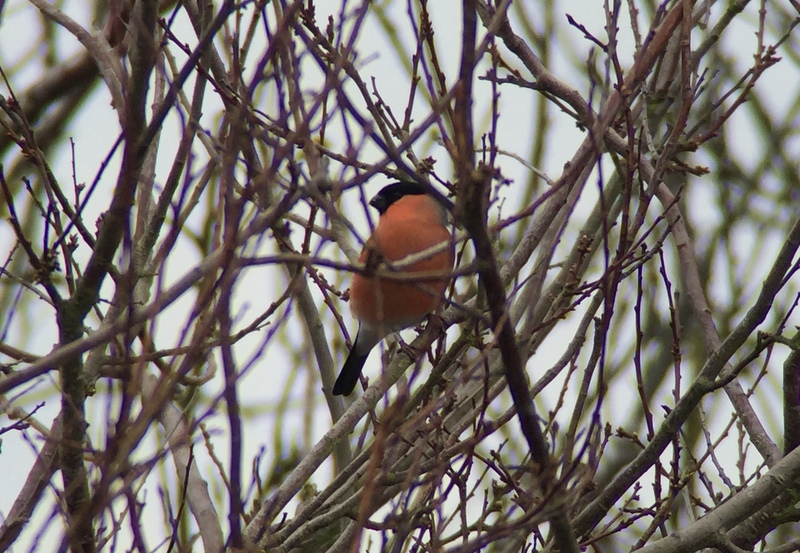 Bullfinch – three were in the car park at lunchtime
Bullfinch – three were in the car park at lunchtime
After lunch, we made our way back along the coast. This would normally be a great time to find Barn Owls out hunting, but strangely there were none out at any of the regular sites we have for them. It had not brightened up as the weather forecast had promised, and the wind had picked up quite a bit (as it had suggested!) – perhaps that was enough to put them off. We stopped in Blakeney and walked out along the seawall. Here at least a Barn Owl was out – although a little distant – hunting back and forth over the grass, stopping to hover occasionally. But there was just one Barn Owl here today and no sign of the hoped for Short-eared Owl.
While we were scanning out across the marshes, some other local birders stopped to talk to us. They mentioned that they had seen a Short-eared Owl at Cley, out hunting that morning. It was exposed and cold in the freshening wind out on the freshes at Blakeney, so we decided to swing round that way instead. We stood up on the East Bank at Cley for a while, watching the Marsh Harriers coming in to roost. A long line of Pink-footed Geese flew in from the east along the coast, calling loudly, before splitting into several skeins and dropping down towards Blakeney – just returning from feeding somewhere or perhaps coming back from the Broads.
The afternoon light was starting to fade, so we made our way inland again. All the regular Barn Owl fields were still empty – something was putting them off from hunting this evening. We had a date with some other owls, so we continued on and drove into the trees.
We were in good time, we should have been a few minutes early, but a Tawny Owl started to hoot already as we were walking down to get in place. We quickened our steps. Then, when we had got ourselves stationed, it all went rather quiet for about ten minutes. A Nuthatch flew in through the gathering gloom and landed on the trunk of a tree in front of us, before disappearing into a hole.
Then some movement in the ivy. The next thing we knew a large shape flew out of the trees and across behind us, a dark shape with wide, rounded wings – a Tawny Owl coming out from its roost. It went a different way to usual tonight, but still thankfully landed up in the trees where we could get it in the scope, briefly. Then it flew again. We made our way round to where it had gone and there it was in the trees. Conveniently, it had landed in a gap in the branches, where it perched in the last of the evening light. Great views of a Tawny Owl through the scope, one of our most nocturnal of owls. It perched in full view for about ten minutes, periodically puffing itself up and hooting. Another Tawny Owl answered from further over in the trees. Finally, it dropped silently away through the branches. The owls had not been their most helpful today, but what a great way to end an Owl Tour.
 Tawny Owl – perched in the trees hooting
Tawny Owl – perched in the trees hooting
















